Another year, another thousand deaths. L.A. homeless crisis hits a crossroads

- Share via
Sometimes I wish I hadn’t seen the body up close, or the small pool of blood that dribbled out of the man’s mouth and onto a West Los Angeles sidewalk. I also wish I hadn’t seen the dead man’s open, empty eyes when he was turned over for examination by the coroner investigator.
The images from that Labor Day weekend are haunting, but I was there for a reason. Alvin Robinson, an African American who was 61 and had suffered through years of mental illness, was the 680th homeless person to die in L.A. County this year.
In the three months since then, the number has grown by roughly three a day, reaching 960 a few days ago. The annual number has increased every year since 2013, and the toll over that span has now surpassed 5,620.
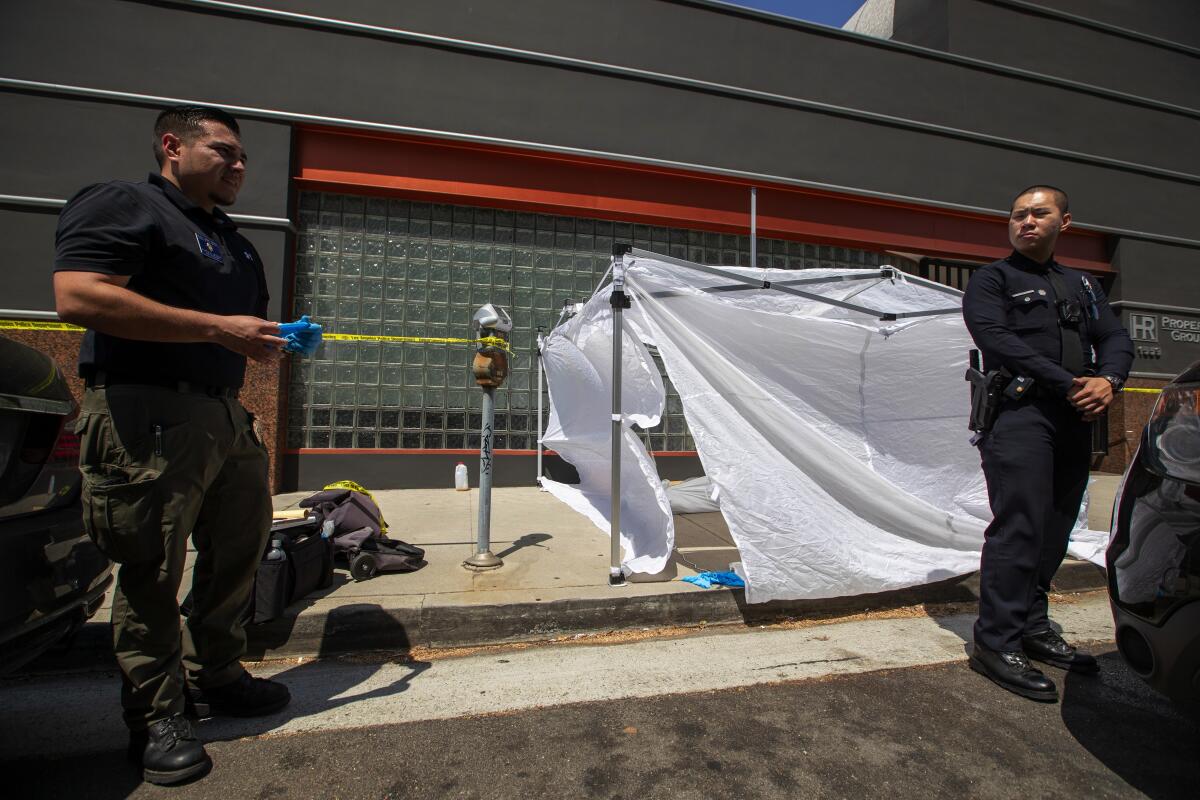
The numbers, staggering if not surprising, punctuate a story we’re all too familiar with.
We’ve come to the end of a year and the end of a decade in which, despite a consensus that something must be done, and despite a massive investment in arresting what local officials have referred to as a humanitarian crisis, the number of unsheltered people climbed to nearly 60,000 early this year.
Sidewalks have disappeared under tents, parks and riverbeds are now villages, uncollected trash has attracted rodents and spread fear of disease, and although more than 100 people are helped off the streets each day, they are outnumbered by the relentless infantry of the newly homeless.
And the vans from the coroner’s office keep rolling.
What have we done wrong? What have we done right? What do we have to do differently in the year 2020 and the years beyond?
We’re not alone, of course. Cities up and down the state and across the nation are trying to figure it out, too. But because of our massive size, our housing crisis and even our mild weather, Greater L.A. is the eye of the storm.
I hear regularly from people distraught by the suffering they see and I hear regularly from those who feel betrayed by elected officials who asked for more money three years ago and promised visible improvements that haven’t yet materialized.
Let’s do more to help the homeless, say some. Let’s get rid of them, say others. And with every passing day, we run the risk that more people will lose empathy.
But I don’t think we’re there just yet.
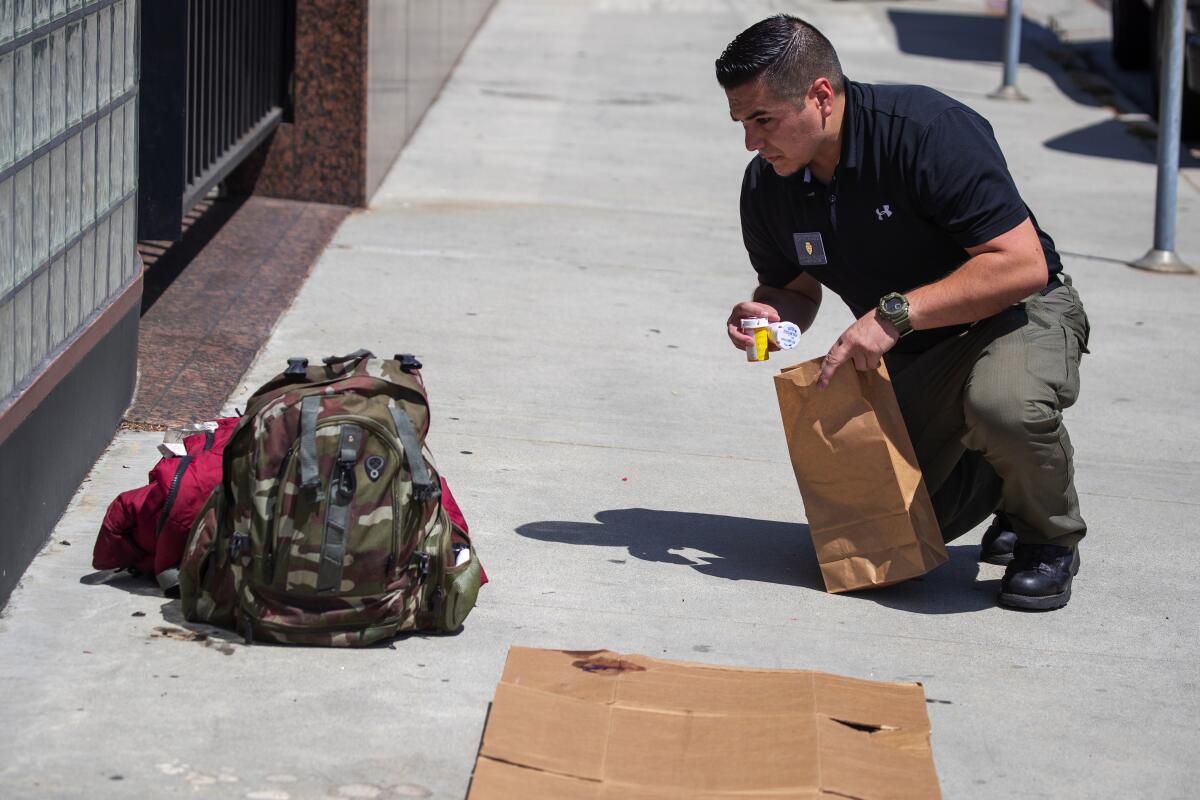
It’s patience, not empathy, that’s running low at this point.
“The electorate is very clear and increasingly so — they want the homeless lifted from streets … and they do not want them incarcerated,” said L.A. County Supervisor Mark Ridley-Thomas. “They are not willing to wait five years for it…. They want it now and they deserve it, and it’s our job to figure it out as leaders.”
That’s a tough mandate, and it remains to be seen whether they can deliver, but recounting what went wrong interests me less right now than what we might do differently. What’s the point of the discussion if we don’t believe there are answers that might work better for everyone — those who are housed and those who are not?
Don’t expect the tents to be folded up anytime soon, because we live in a place where prosperity drives poverty, where even the rent on converted garages is ridiculous, where a school in Pacoima is surrounded by the carcasses of long-ago job factories. Skid row didn’t happen by accident. We tilted the field and then snipped the net that caught those falling out of the dream. And now homeless encampments are as abundant in L.A. as $10-million homes.
The only good thing I can see about skid rows popping up in every part of town, as they have in recent years, is that maybe the graphic, everyday evidence of our epic disaster will help drive a greater sense of urgency. After all, the public clamor for solutions is at a pitch, with a recent poll putting homelessness as a top concern for 95% of registered voters. That being the case, I can’t imagine anyone running for office without voters demanding the outline of a strategy, a real strategy, and by now we can all spot the pretenders.
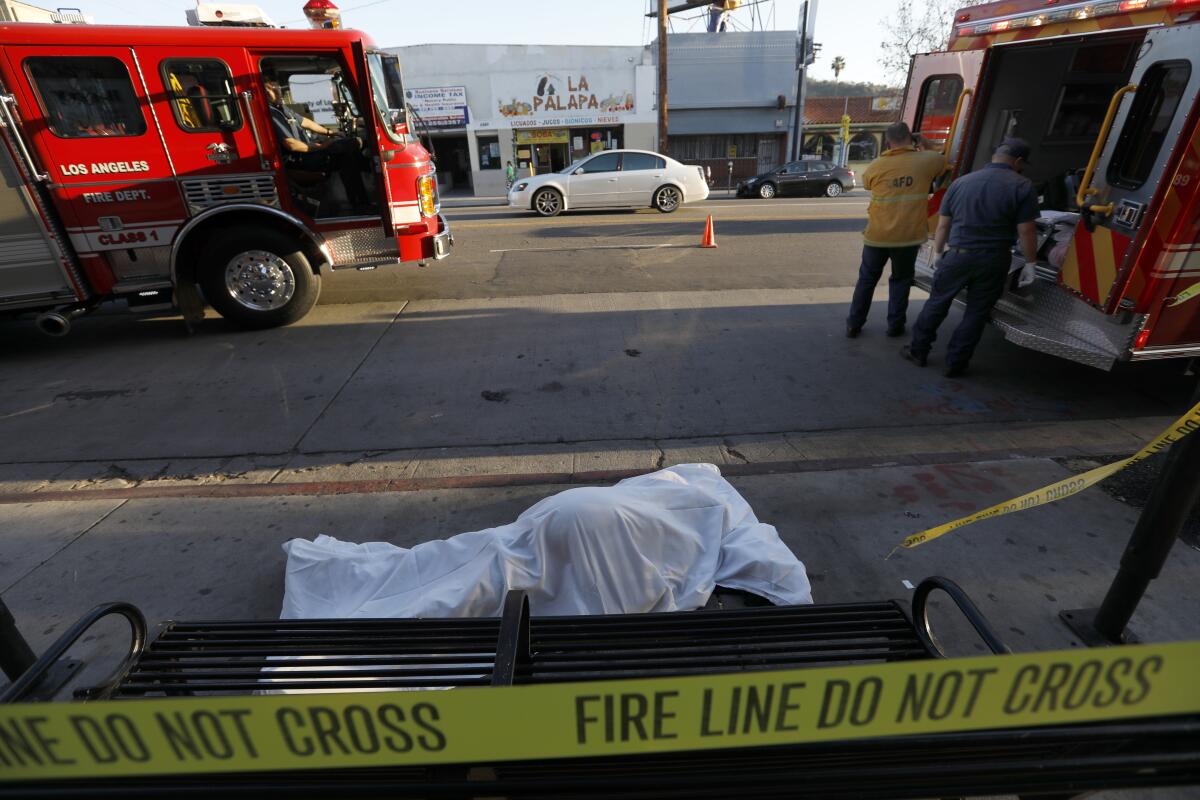
To be fair, Los Angeles hasn’t ignored homelessness. Not in the least. I don’t know of a place with more people in the public, private and nonprofit sectors who have devoted themselves to the cause, and despite disappointments aplenty, the seeds have been planted for more housing in the near future.
And if I stand on a ladder, adjust my glasses and peer into the next year, I do see a glimmer of hope, in part because a skirmish has broken out among the people in charge of charting strategy.
That’s a good thing, you ask?
Maybe so, and here’s why: If there’s anything we know about this crisis, it’s that there isn’t a simple solution. Now that we have started building a solid foundation of permanent supportive housing to get people off the streets — a crucial step — we are starting to hear calls for fresh approaches, new ideas and even bold risks to build on what’s already in place.
The most controversial proposal in play comes from Ridley-Thomas and Sacramento Mayor Darrell Steinberg. Do whatever it takes, they say (means and manner to come), to make sure everyone in California has at least a temporary place to stay. And then — here’s the more controversial piece — require that everyone move indoors.
Apoplectic critics feel betrayed by two guys who’ve been in the fight for years suddenly supporting what sounds like coercion to get resistant people off the streets. The critics also blasted Steinberg and Ridley-Thomas for advocating more shelters, when they are only a temporary fix, and the criticism continued even after the two said they were talking about all types of housing, not just shelters. It got ugly, with some critics accusing the duo of wanting to warehouse people rather than help them, and of trying to criminalize homelessness.
And Ridley-Thomas may have given his critics additional ammo in September, when he cast the deciding vote for L.A. County to support the challenge of a court ruling that made it illegal to arrest or punish people for sleeping outdoors if no housing is available for them.
If we start arresting people for being homeless, shame on us. But I’ve talked to Ridley-Thomas and Steinberg many times, and unless I’m misreading them, I don’t think they’ll be reaching for the handcuffs any time soon.
Their argument is that we’re not building permanent supportive housing units fast enough to keep up with the demand, and we’ll never catch up, even as people get sicker and die on the streets. Bringing everyone inside is a first step toward long-term solutions, they say, and they believe the vast majority of people now homeless would gladly take a bed and a roof, even if it’s only temporary.
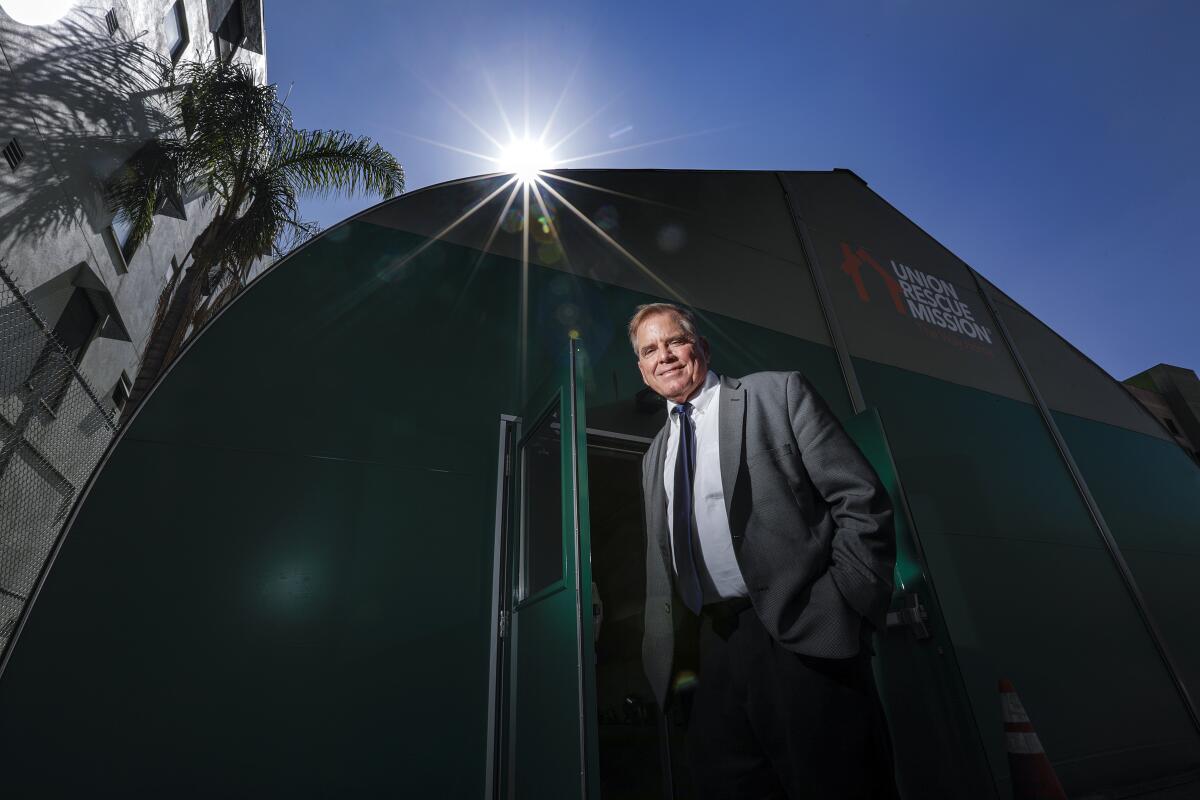
This is more of an idea than a plan at the moment, so they don’t have details worked out yet but say better use of existing funds, as well as a redistribution of money from the Mental Health Services Act, could help cover the costs of building various kinds of temporary housing.
Here’s another healthy sign of new directions:
Sarah Dusseault, who chairs the commission of the Los Angeles Homeless Services Authority, is calling for a rethinking of the structure and strategies of the agency that blends city, county and nonprofit interests but doesn’t answer directly to the public or to any other single entity that can be held accountable.
Her proposal has led to a good deal of hand-wringing and whispering by critics invested in the status quo. Let me just say here that LAHSA and its many street soldiers have done noble work, but structural tweaks big and small could be healthy, in my opinion. Now is the time to ruffle feathers.
Speaking of which, I fielded more than a bit of grief for a series of columns last month on homelessness in Hollywood, where those who supported a temporary shelter are disappointed in the early results. Encampments got bigger rather than smaller, drugs of every sort are sold and ingested in plain view, and one longtime, devoted but frustrated service provider declared: “We need new tactics.”
Some found the tone of my columns harsh, partly because I questioned whether we’re getting help to those who need it most and asked whether we have the resources to help recent arrivals lured by the Hollywood mystique, even as severely disabled homeless people languish.
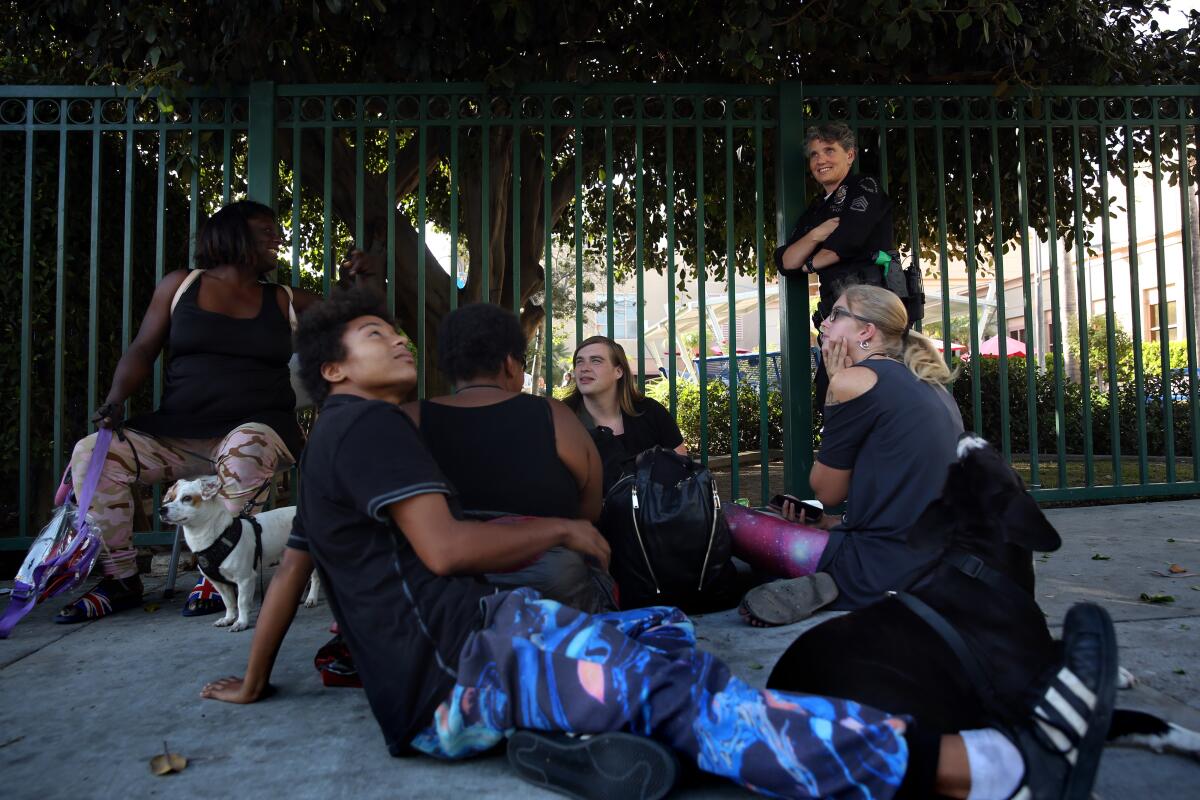
The criticism came from, among others, the very people invested in the strategy whose central component is permanent supportive housing, which involves first getting people into housing and then providing the services they need to keep them off the streets, whether it’s drug treatment, mental health care or something else.
Permanent supportive housing is still the gold standard. I’ve been such a true believer that many years ago, at the request of a homeless services pioneer and personal hero of mine — Sister Mary Scullion of Philadelphia — I testified at a congressional briefing on the merits of the concept and how it had helped my buddy Nathaniel Ayers move inside after living for years on L.A.’s skid row.
But in Los Angeles, building that kind of housing takes too long and costs too much to be the sole solution.
“We are on the path to build 10,000 new units of supportive housing by 2026,” said a letter to the editor in response to my Hollywood columns.
That’s the equivalent of telling a community wiped out by a tsunami to hold on, because help will be coming in six or seven years to a small fraction of those who are displaced. Why so long, and what about the other 50,000 people currently homeless, as well as the thousands more who are likely to join them by 2026?
Many of those who view permanent supportive housing as the best approach fear that spending on different approaches would divert money from the asset we need most — long-term housing. I understand the concern.
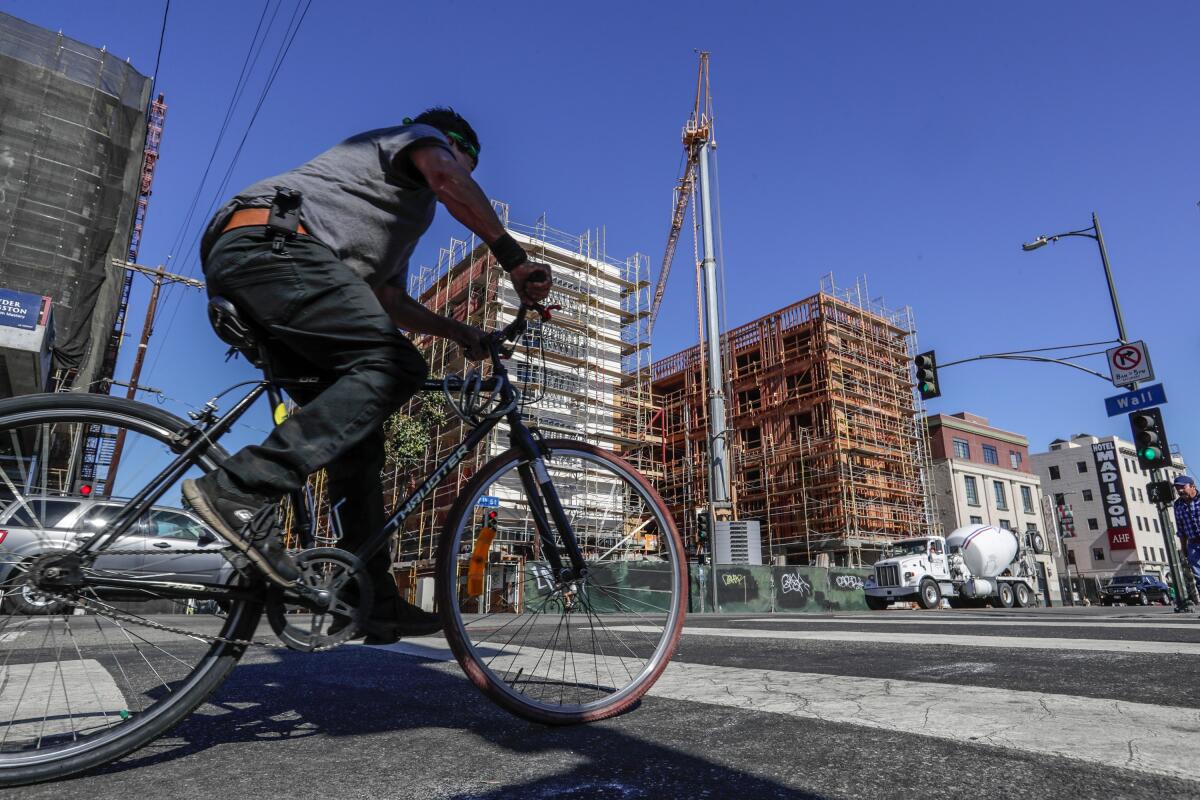
But we’re losing the battle. We need to double and triple down on the temporary, transitional and interim housing programs already in play, which can help in the short term. We need a massive infusion of just plain affordable housing, the will and innovation to make it happen, and consequences for communities that don’t do their part. And we need new ideas.
We need to do more to prevent people from becoming homeless in the first place. We need to think about developing managed encampments.
To the extent that financial stress and unemployment push able-bodied people onto the streets, let’s invest more in programs like the one run by Chrysalis on skid row, where formerly homeless people get jobs cleaning the streets. I met with a man earlier this year who went through the program, graduated to a job at the California Department of Transportation and was about to buy a house.
Let’s bulldoze the barriers to new housing construction but also, finally, take better advantage of existing public property and buildings, and vacant private buildings too. L.A. County Supervisor Kathryn Barger called last week for a public-private collaboration on new homeless housing, telling The Times “it’s not working the way we are doing it.”
Let’s move forward on protecting civil liberties but not letting them stand in the way of helping people who are obviously gravely disabled, mentally or physically.
Let’s finally get more safe harbors for people living in vehicles, because there’s no reason we can’t do as well as Santa Barbara and San Diego.
We need way, way, way more addiction services because an epidemic is playing out in full public view and we need way, way, way more mental health intervention because every one of us can point out the suffering souls in our neighborhoods.
We need to try new things now, not in a few years, and we need to run, not walk.
And let’s be realistic. We’re never going to end homelessness, given the myriad causes, so let’s quit making empty promises or suggesting we’ve begun to figure out all the appropriate responses.
We haven’t. It’s a work in progress. Let’s talk, let’s disagree, let’s keep moving, let’s remember that every day, hundreds of dedicated public and nonprofit people are on the front lines, trying their best to make a difference, and let’s honor their work with a more coherent and comprehensive strategy.
The stories of homeless people are often complicated, messy, difficult to fully comprehend. Some have made bad choices, some have been pushed out by exhausted relatives, some prey on other homeless people and survive on crime.
But in my 15 years of observation in Los Angeles, the vast majority of people who end up with nowhere to go have been hammered to varying degrees by poverty, mental illness, physical disease and addiction. They are battered women and survivors of sexual abuse. They know the hell of abandonment and the trauma of violent crime. They know housing discrimination and generations of misery. And they often meet early death.
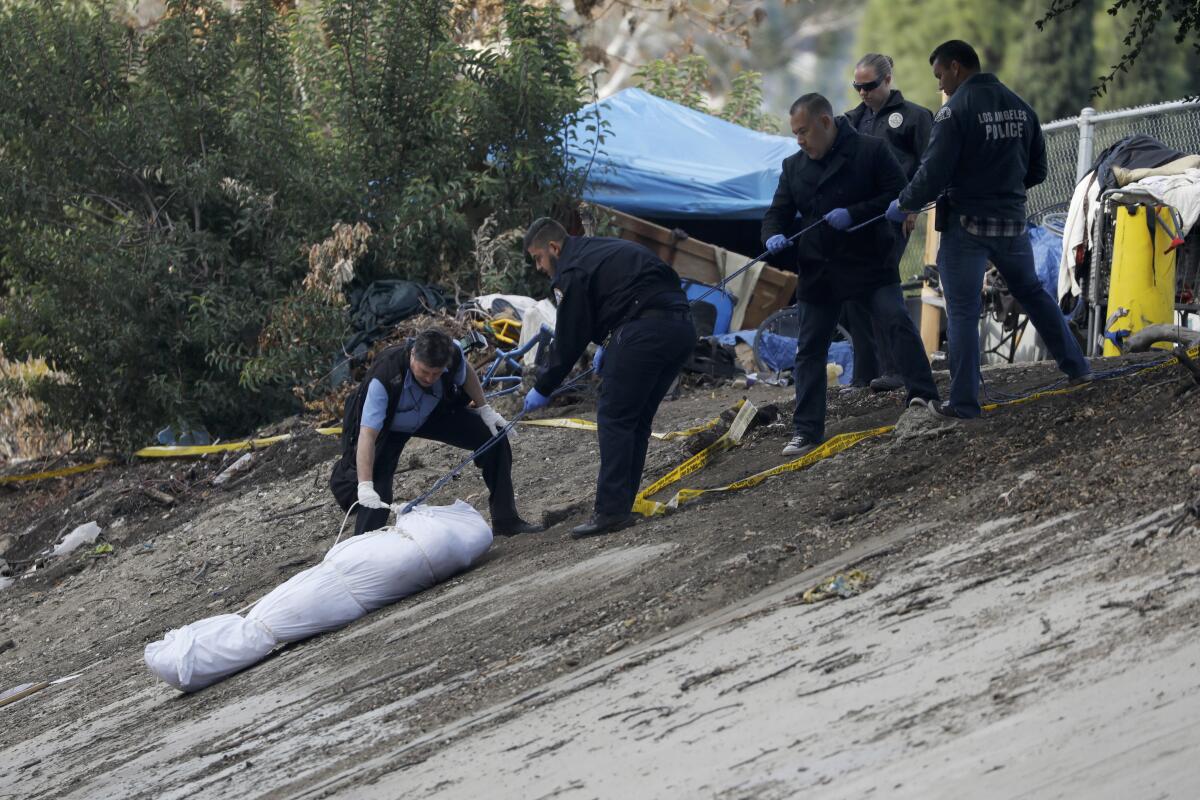
Death by suicide. By homicide. By accident. By heart disease. And by addiction, which was a factor in 27% of all homeless deaths between 2013 and 2018 according to an L.A. County Department of Public Health study.
As of September, the average age of death for homeless people who had died this year was 51, or roughly 30 years below the county’s average life expectancy of 80. I’ll never forget Alvin Robinson’s heartbroken wife, Lola, telling me about all the years she hoped he would admit he needed help, that he would finally get it, and that he’d come back home.
I’ll never forget taking her to the medical examiner’s office, where, finally convinced that her husband was gone, she collapsed in a storm of grief.
Winter has set in now, the rains have come, the death toll is rising.
On Wednesday this past week, a Los Angeles County Department of Medical Examiner-Coroner’s team rolled out on a morning call to the railroad tracks near the 19200 block of Prairie Avenue in Torrance, where the body of a homeless white man had been found. The man was identified as Nelson Reid III, 29, cause of death pending.
That was homeless death No. 961.
A few hours later, at 1:20 p.m., a homeless Hispanic man in his 70s was found dead in a vehicle in the 1000 block of South Park View Street in Los Angeles. Next of kin had not been notified and cause of death is pending.
That was homeless death No. 962, another silent passing that must be heard as a scream, a call to compassion, a commitment to urgency.
More to Read
Sign up for Essential California
The most important California stories and recommendations in your inbox every morning.
You may occasionally receive promotional content from the Los Angeles Times.














